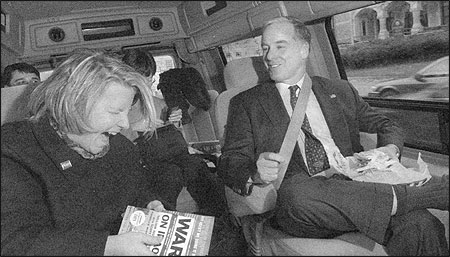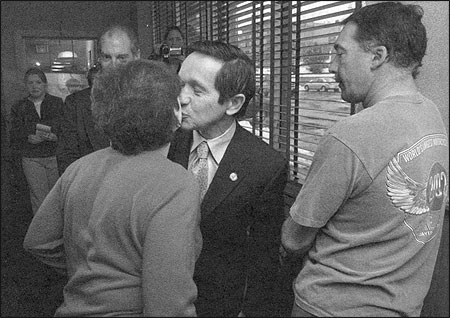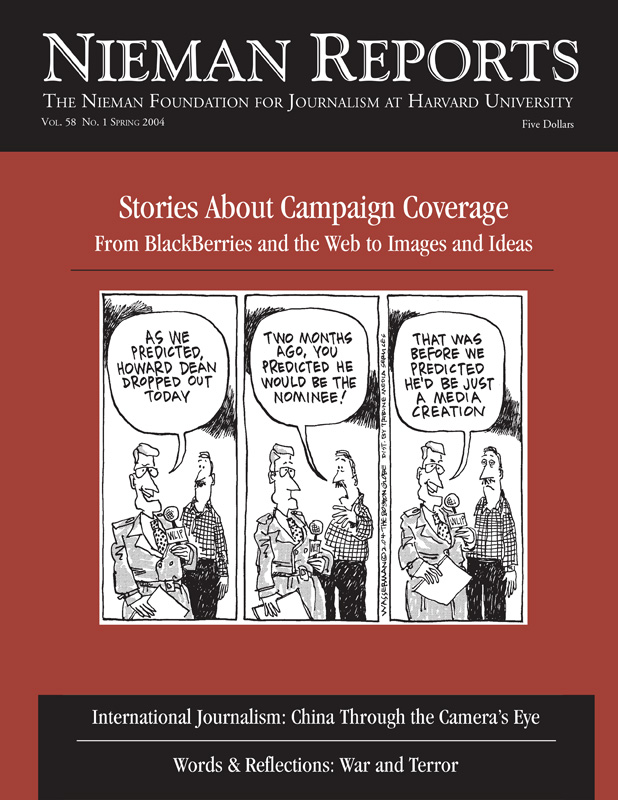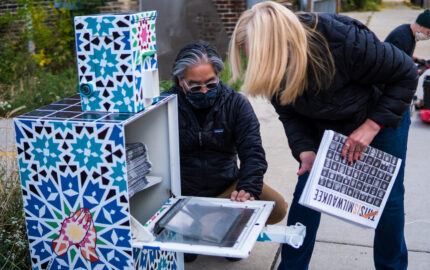
Governor Howard Dean jokes with New Hampshire state campaign director, Karen Hicks, after officially signing up for the New Hampshire presidential primary in Concord in November 2003. Photo by Dan Habib/Concord Monitor.
Covering the New Hampshire primary is a tense dance between photographers and campaign staff. Campaigns carefully plan events and arrange settings to mold how they’d like to convey the candidate’s image, while photographers seek out engaging moments to communicate a truer nature of the candidate and the campaign. The images we publish at the Concord (N.H.) Monitor matter because potential voters—short on time and attention—often rely on them to arrive at judgments about candidates’ temperaments, stature and work ethics. In our visually driven culture, images influence voters.
Campaigns know the photographs they’d like us to print. In them, there’d be hundreds of swooning supporters cheering and waving signs. But for our purposes, photographs of candidates smiling near sign-waving supporters are stale. This goes for flapjack flips and when campaign buses are used as props.
For us to give our readers the fresh look at the candidates that they deserve means that campaigns—which crave high visibility in local media—need to find more creative photo ops, provide a lot of unscripted access to the candidate, and have steady, spontaneous contact with voters.
Negotiating for Access
During each primary season, Monitor photographers negotiate with each candidate to get one day of unfettered access to the campaign. Although campaigns take some risk in granting this behind-the-scenes access, they also stand to gain by it if we can come away with photographs that give readers insight into the political process and the personality of the candidate and their staff. In 2000, Senator John McCain gave the media, in general, nearly unlimited access during his New Hampshire primary run, and his openness was one reason he beat George W. Bush in the primary by 18 points. To voters, whatever else they thought of him, they believed he wasn’t hiding anything.
During November 2003, candidates came to the New Hampshire State House to file papers to appear on the primary election ballot. Each campaign took a different approach in trying to create a worthy photo op. Senator Joe Lieberman brought his mom along. Senator John Kerry brought a group of veterans from Massachusetts. Several days before former Vermont Governor Howard Dean’s filing, I spoke with his campaign to arrange time in the candidate’s van between events. I shot the filing event, including a short speech made to scores of supporters outside the State House. During my 10 minutes in the van, I made a photo of Dean grabbing lunch as Karen Hicks, his state campaign director, laughed next to him.
On the next day’s front page of the Monitor that photo appeared. Hicks asked me why we used the van picture rather than a shot of him and his supporters. I explained that this image offered readers a more unusual and real glimpse of Dean and what it was like for him to campaign. Since there was no story planned that day, it was either that photo on Page One or no photo at all. “I’ll take it,” she said.
The Staging Game
The Monitor’s ethics policy forbids reporters and photographers to stage, alter or re-enact news events. Though not everyone in the media subscribes to this practice, we do not ever stage direct the candidates.
An example of such stage directing happened when members of the media gathered for General Wesley Clark’s State House arrival. They were told he’d be entering by a back door. A TV reporter protested that it would be a much better visual if Clark walked up the front steps. Campaign cell phones buzzed, and the plan changed to having him walk up the front steps. On another day, Congressman Dennis Kucinich was part of a blind date, arranged by PoliticsNH.com. This breakfast get-together grew into a major publicity stunt. As he left the date, Kucinich gave Gina Marie Santore a parting kiss near about a dozen cameras. “Do it again, we missed it!” a television reporter shouted. Kucinich and Santore obliged.
When I criticized the practice of stage directing recently to a magazine photographer colleague, he said that if he didn’t come back with pictures to publish, he wouldn’t get paid. Others in the media argue that because events are so staged anyway, why not help the campaigns do it better?

Dennis Kucinich kisses Gina Marie Santore of New Jersey after a breakfast first date at the Holiday Inn in Concord, New Hampshire. Santore was selected from an online “Who wants to be a first lady?” contest conducted by PoliticsNH.com. Photo by Dan Habib/Concord Monitor.
The Final Stretch
There are really two primary seasons in New Hampshire—the one before Iowa and the one after Iowa. When candidates start visiting the state about a year before the primary, our newspaper’s photographers encounter few other cameras at campaign events. Of course, as months pass, the media pack grows, but before the Iowa caucuses it rarely exceeds a dozen cameras at any event. After Iowa, it is not uncommon to have 50 or more cameras at a major candidate’s event.
This year we tried several approaches to make sure that during that post-Iowa week the newspaper had strong, original photography. Throughout the primary we published a photo column called Primary Life: Scenes from the edge of the campaign trail. In it, we featured interesting people and moments from the campaign that didn’t involve the candidates. Day-in-the-life photo pages that we’d shot in December and early January ran on the seven days leading up to the Election Day. On the day when votes were cast, we focused on the voters and published a page of images taken in polling places throughout our region.
Most importantly, during that final week we called upon a year’s worth of relationships that we’d built with top campaign staff. We negotiated hard with the campaigns for extra access each day. As a result, that week photos of Kerry slugging down water on his campaign bus or of Dean huddling with top staff after the Iowa embarrassment led section fronts. Conventional photo ops, contrived by the campaigns, were often bypassed or buried inside. On the night of the election, however, our photographers were relegated to the risers along with dozens of others. After all, Wednesday morning’s photos would not bring any of the candidates a single extra vote.
Dan Habib is photo editor of the Concord Monitor. Working with staff photographers Elaine Skylar, Preston Gannaway, Ken Williams, and intern Jim Korpi, Habib has just finished his fifth New Hampshire primary for the Monitor. This is an updated version of a story that appeared in the Monitor on December 14, 2003. Some of the Monitor’s photo coverage of the primary campaigns can be viewed at www.concordmonitor.com.



